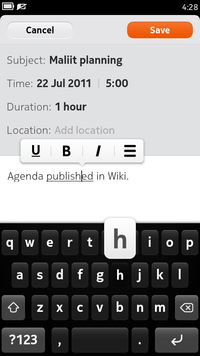Maliit
|
Maliit’s virtual keyboard running on the Nokia N9 | |
| Original author(s) | Nokia |
|---|---|
| Developer(s) | Jan Arne Petersen and contributors[1] |
| Initial release | June 30, 2010[2] |
| Stable release |
0.81.4
/ February 1, 2013[3] |
| Preview release |
0.99.1
/ November 14, 2015[4] |
| Development status | Active |
| Written in | C++ |
| Operating system | Unix-like, Windows[5] |
| Platform | Qt |
| Available in | Multilingual |
| Type | Input method |
| License |
GNU LGPL (framework) BSD license (plugins)[6] |
| Website |
maliit |
Maliit an input method framework for computers with particular focus on implementing virtual keyboards.
Designed mostly for touchscreen devices, Maliit allows the inputting of text without the presence of a physical keyboard. More advanced features such as word correction and prediction are also available.
Originating as part of MeeGo,[7] Maliit is free software licensed under LGPL. Maliit was deployed as a standard component of Nokia N9,[8] KDE Plasma Active,[9] LuneOS,[10] OLPC devices,[8] and Ubuntu Touch.[8][11][12]
History
Maliit was originally developed as part of MeeGo by Nokia who eventually shipped it as part of MeeGo Handset “Day 1” software platform.[2]
After the MeeGo project ended, Maliit was transferred into an independent project by free software consulting firm Openismus.[13] The first formally independent release was 0.80.0 on June 20, 2011.[14]
Maliit 0.99, released on March 27, 2013, switched from Qt 4 to Qt 5.[8]
Features
Among Maliit’s features are a plugin-based architecture, word correction and prediction, multitouch, and context sensitive layouts.[15]
When running on Linux kernel, handling of the input hardware relies on evdev. Maliit has been adopted by X11 as well as by Wayland.[8]
See also
External links
References
- ↑ "Contributors to maliit/framework". GitHub.
- 1 2 "Handset Project Day 1 is Here". MeeGo. 2010-06-30. Retrieved 2013-03-04.
- ↑ "[Maliit-announce] Maliit 0.81.4 released". Lists.maliit.org. Retrieved 2013-04-03.
- ↑ "Maliit 0.9.1 Release". maliit.github.io. 2015-11-14. Retrieved 2015-11-14.
- ↑ Jon Nordby (March 24, 2012). "Maliit on Windows: Basic build working". Jonnor.com. Retrieved 2013-03-04.
- ↑ "[MeeGo-dev] ANNOUNCEMENT: MeeGo Keyboard license is now changed to BSD". Lists.meego.com. Retrieved 2013-03-04.
- ↑ Jan Arne Petersen (2012-01-25). "Compositing in Maliit". Retrieved 2013-03-04.
- 1 2 3 4 5 Michael Hasselmann (April 2, 2013). "Maliit Status Update". Archived from the original on 17 May 2013. Retrieved 2013-04-03.
- ↑ Carl Symons (October 15, 2012). "Plasma Active 3 Improves Performance, Brings New Apps". KDE.News. Retrieved 2013-04-03.
Thanks to a new virtual keyboard based on Maliit—the input method used on devices such as Nokia's N9 smartphone—Plasma Active Three makes text input easier.
- ↑ "webOS-ports/webos-keyboard". GitHub.
- ↑ Murray Cumming. "Maliit Keyboard Improvements". Retrieved 2013-03-04.
- ↑ "ubuntu-keyboard in Launchpad". launchpad.net.
- ↑ "[Maliit-announce] Welcome!". Lists.maliit.org. Retrieved 2013-03-04.
- ↑ "[MeeGo-dev] Maliit "Brave New World" 0.80.0 released". Lists.meego.com. Retrieved 2013-03-04.
- ↑ "Features – Maliit wiki". Maliit.org. 2012-03-28. Retrieved 2013-03-04.
